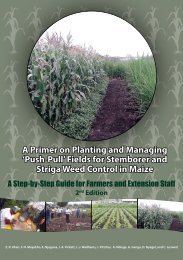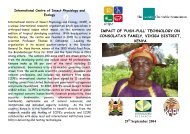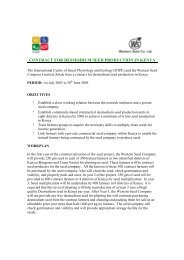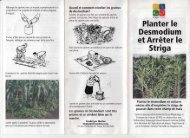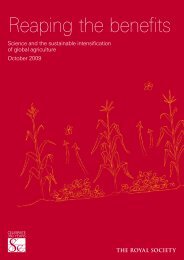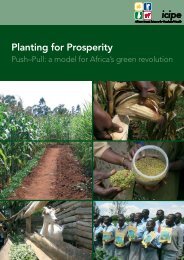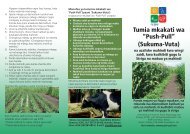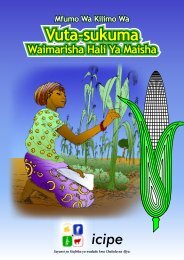Biology and management of economically important ... - Push-Pull
Biology and management of economically important ... - Push-Pull
Biology and management of economically important ... - Push-Pull
You also want an ePaper? Increase the reach of your titles
YUMPU automatically turns print PDFs into web optimized ePapers that Google loves.
704 KFIR ET AL.<br />
The other invasive species, C. sacchariphagus, is a serious pest <strong>of</strong> sugarcane<br />
in the Indian Ocean Isl<strong>and</strong>s. C. sacchariphagus may have been accidentally introduced<br />
into the isl<strong>and</strong>s either from Sri Lanka or Java with the introduction <strong>of</strong><br />
sugarcane around 1850 (222). There are recent confirmed reports <strong>of</strong> C. sacchariphagus<br />
attacking sugarcane in Mozambique (209).<br />
Some <strong>of</strong> the more <strong>important</strong> native species have restricted distributions, whereas<br />
others are found throughout sub-Saharan Africa. C. orichalcociliellus, a pest <strong>of</strong><br />
maize <strong>and</strong> sorghum, occurs in coastal East Africa, Malawi, <strong>and</strong> Madagascar at<br />
altitudes below 600 m (51, 108, 127). C. aleniellus has been reported as a pest <strong>of</strong><br />
rice in West <strong>and</strong> Central Africa <strong>and</strong> more recently as an <strong>important</strong> pest <strong>of</strong> maize<br />
in Ivory Coast (120). C. ignefusalis is the dominant stem borer <strong>of</strong> millet in the<br />
Sahelian zone <strong>of</strong> West Africa (69).<br />
E. saccharina is widely distributed in Africa <strong>and</strong> has been reported from several<br />
grasses <strong>and</strong> sedges (23, 45, 61, 78). In southern Africa, E. saccharina is a major<br />
pest <strong>of</strong> sugarcane but rarely causes damage in maize (177). In contrast, E. saccharina<br />
is considered to be a pest <strong>of</strong> maize, sugarcane, <strong>and</strong> rice in West Africa<br />
(32, 64, 159, 174).<br />
B. fusca <strong>and</strong> Sesamia spp. occur throughout subsaharan Africa (79). Of the<br />
Sesamia spp., S. calamistis is the most widely distributed <strong>and</strong> <strong>economically</strong> <strong>important</strong><br />
species, but several others, including S. cretica, which occurs in Somalia,<br />
Sudan, <strong>and</strong> Ethiopia, <strong>and</strong> S. nonagrioides botanephaga, which is found in both<br />
East <strong>and</strong> West Africa, are also <strong>important</strong>. As with E. saccharina, the pest status<br />
<strong>of</strong> B. fusca varies by region. In East <strong>and</strong> southern Africa it is a pest at higher altitudes<br />
(>600 m) (127, 178), but in West Africa, B. fusca occurs from sea level to<br />
>2000 m (187) but is primarily a pest in the dry savanna zone (68).<br />
DIAPAUSE<br />
Many cereal stem borers have a resting period toward the end <strong>of</strong> the cropping<br />
season, which they spend as fully grown larvae in dry crop residues in the fields. In<br />
Kenya, C. partellus, S. calamistis, <strong>and</strong> C. orichalcociliellus enter diapause for several<br />
months in the dry season (130, 161, 163). However, S. calamistis was reported<br />
not to enter diapause in Ug<strong>and</strong>a (78) or in Nigeria (68). In West Africa, B. fusca<br />
enters diapause during the dry season, <strong>and</strong> it takes up to six months to complete<br />
development. With the initiation <strong>of</strong> the rains, the larvae pupate within the stems,<br />
<strong>and</strong> 10–12 days later adult moths emerge (68). Similar observations were made<br />
on C. ignefusalis, which has a facultative diapause in dry millet stems (226).<br />
In southern Africa, B. fusca <strong>and</strong> C. partellus pass winter in diapause, which is the<br />
cold dry season (April–September), in the lower parts <strong>of</strong> the dry stalks, where they<br />
are well protected from natural enemies <strong>and</strong> adverse climatic conditions (83–85).<br />
B. fusca diapauses throughout its distribution in Africa, whereas C. partellus does<br />
not diapause in the warm low-lying regions <strong>of</strong> the South African Provinces <strong>of</strong><br />
Kwazulu-Natal (203) <strong>and</strong> Mpumalanga (R. Kfir, unpublished data), Swazil<strong>and</strong>



